How to Design a Rain Garden That Loves Stormy Weather
http://www.decor-ideas.org 10/07/2015 02:13 Decor Ideas
Rain gardens allow stormwater runoff to infiltrate the soil and return water to the aquifer. They also offer a great new garden bed for the home landscape. This article, the fourth in a series about rain gardens, addresses some of the concerns with how the rain garden looks. Once you’ve made your rain garden functional by choosing the best location, creating the right soil and selecting the right plants, read these design tips to help it look its best.
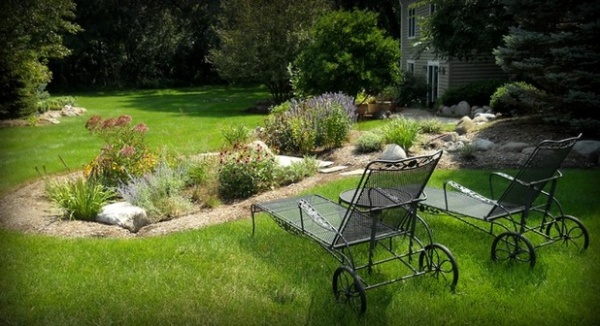
Work With What You Have
Look at your overall space and take a mental inventory of what is already working well. Maybe you have a favorite tree or flowering shrub that becomes more beautiful each year. Perhaps you adore having a bright, sunny spot in the garden or an extra-lush border. Take stock of your garden’s assets and think about how a rain garden will enhance them. The rain garden design here creates a lush border and enhances the healthy lawn surrounding it.
Plants shown: Joe Pye Weed (Eutrochium sp.), black-eyed Susan (Rudbeckia hirta), prairie dropseed (Sporobolus heterolepis), sedge (Carex sp.), blazingstar (Liatris sp.)
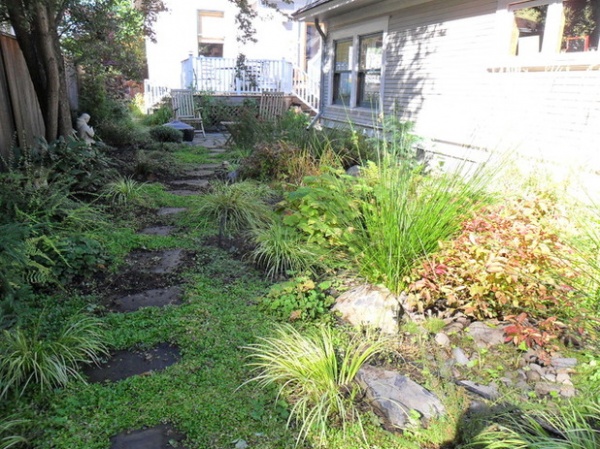
Incorporate your existing layout. A rain garden can be incorporated into an existing garden bed by reworking the soil and bringing in new plants. You can also incorporate a rain garden into an existing garden bed by extending the bed to capture rainwater from an adjacent slope.
The rain garden above, designed into a narrow side yard, accommodates an adjacent steppingstone path. The creeping mazus (Mazus reptans) ground cover between the steppingstones merges wonderfully with the mix of rain garden plants.
Plants shown: Golden sweet flag (Acorus gramineus ‘Ogon’), common rush (Juncus effusus), ‘Little Henry’ sweetspire (Itea virginica ‘Little Henry’), thimbleberry (Rubus parviflorus)
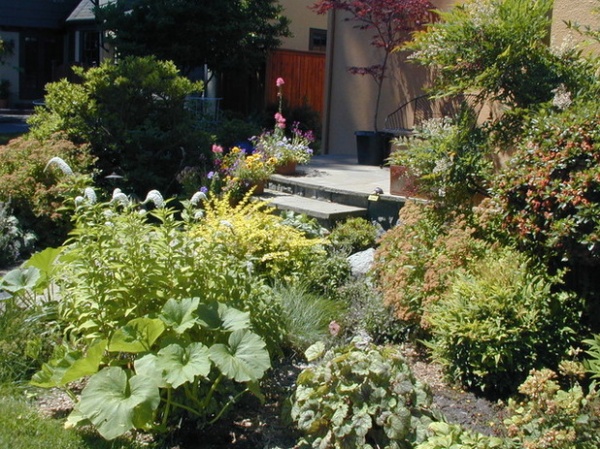
Design with your overall landscape in mind. Another way to work with what you have is to choose plant textures, colors and forms for your rain garden that complement your existing plants. Do you want your rain garden to stand out, to distinguish itself from other parts of your landscape? Or to blend with your existing garden? These are very subjective questions, and it is up to you how you want your garden to look. The rain garden above is so well blended with the overall garden that it’s unclear where the rain garden begins and ends.
Plants shown: ‘Moon Bay’ heavenly bamboo (Nandina domestica ‘Moon Bay’), blue fescue (Festuca glauca), ‘Magic Carpet’ spirea (Spiraea japonica ‘Magic Carpet’), ‘Aurea’ barberry (Berberis thunbergii ‘Aurea’)
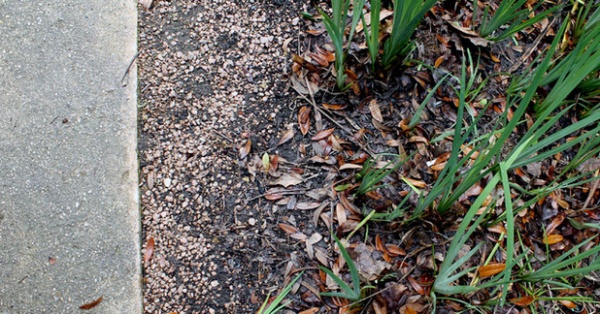
Avoid Washout and Erosion
The point where your inflow of water meets the rain garden is susceptible to erosion, because water will be repeatedly hitting the ground with force. Place stones at the edge that won’t float away in the storm. A stone 2 to 3 inches across will help to break up the rushing water, but smaller gravel can work in areas sloped less than 3 percent. Avoid small stones on steep slopes, because they will be washed out. The goal is to choose a stone size that will help spread out the water as it meets the rain garden.
Another option is to plant a woody, spreading ground cover that can withstand the water inundation. Some examples include creeping barberry (Mahonia repens) or kinnikinnick (Arctostaphylos uva-ursi). If you choose to establish some ground cover, it’s best to fill in any gaps between the young plants with stones. Over time, the plants will grow and spread to cover the smaller stones.
Shown: A concrete walkway that is sloped to drain water into a rain garden. Small crushed stone on the perimeter of the planting bed helps buffer the water and spread it into the rain garden. The plant here is Louisiana Iris (Iris brevicaulis).
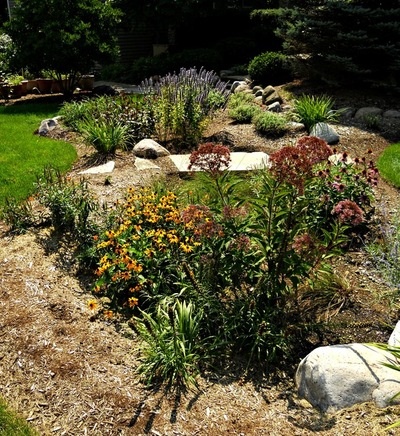
Plant for Fullness Over Time
The rain garden, just like any newly planted garden, will take time to grow in and really come to life. The initial planting and spacing should be based on the plants’ mature spread, giving them room to grow. Avoid placing plants too close together, as you’ll end up with overcrowded plants that require more maintenance because they’ll need to be thinned periodically. Here’s a rain garden still in the early years but filling in nicely as the plants spread out and mature.
Plants shown: Joe Pye Weed (Eutrochium sp.), black-eyed Susan (Rudbeckia hirta), prairie dropseed (Sporobolus heterolepis), sedge (Carex sp.), blazingstar (Liatris sp.)
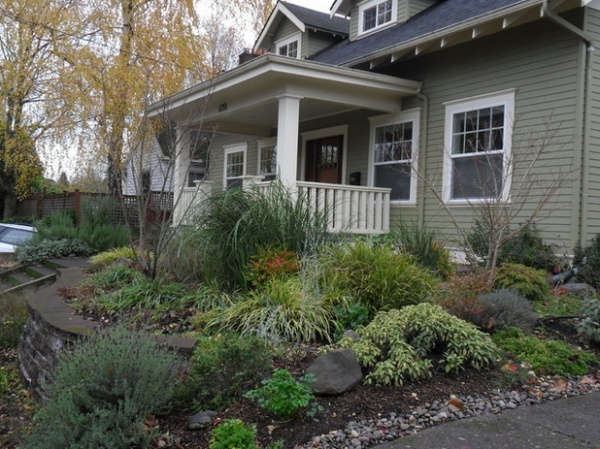
Use Woody Plants for Winter Interest
Rain gardens don’t have to be all grasses and herbaceous plants. Woody plants — shrubs and trees — will add winter interest, even if they are deciduous. In this Portland, Oregon, rain garden woody plants intermingle with grasses and perennials to create year-round interest.
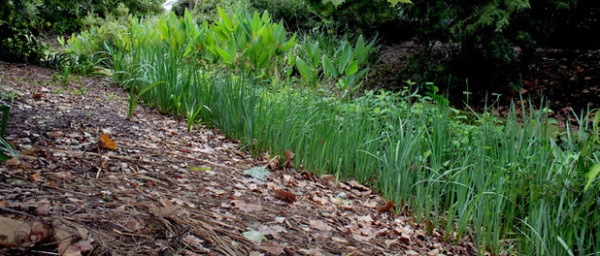
Take Notes From an Established Rain Garden Near You
A key part of designing your rain garden and keeping it looking its best is to study nearby established rain gardens. Rain gardens are growing in popularity, but they are still a specialty in the landscape. Visit a nearby established rain garden and take notes on how well the planting is doing, what species are doing best, how it looks throughout the year and how the stones or mulch is holding up over time.
Shown: A shaded slope that drains into the rain garden of the Houston Zoo parking lot. The plants in the wet zone are expertly layered with a combo of the fine foliage of Louisiana iris (Iris brevicaulis) at the edge and the taller, broader-leaved foliage of a water-loving powdery thalia (Thalia dealbata) in the center.
More
To Manage Stormwater Sustainably, Understand Your Site
Stormwater Planters Manage Runoff in Small Gardens
More guides to landscape design
Related Articles Recommended












